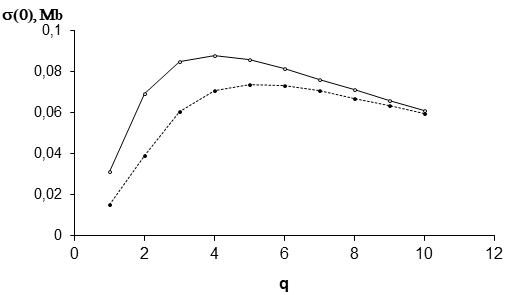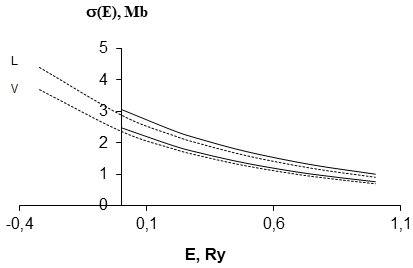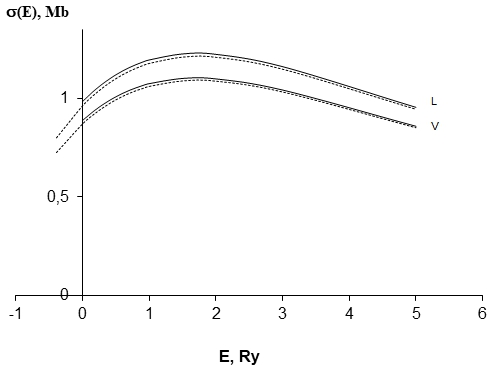CALCULATION OF THE PHOTOIONIZATION CROSS SECTIONS FOR THE IONS OF THE CESIUM ISOELECTRONIC SEQUENCE BY THE DIRAC-FOCK METHOD
ВЫЧИСЛЕНИЕ ПО МЕТОДУ ДИРАКА-ФОКА СЕЧЕНИЙ ФОТОИОНИЗАЦИИ ДЛЯ ИОНОВ ИЗОЭЛЕКТРОННОЙ ПОСЛЕДОВАТЕЛЬНОСТИ ЦЕЗИЯ
Научная статья
Зилитис В.А. *
ORCID: 0000-0002-1692-9493,
Институт математики и информатики Латвийского университета, Рига, Латвия
* Корреспондирующий автор (zilitis[at]latnet.lv)
АннотацияРелятивистским методом самосогласованного поля Дирака-Фока вычислены сечения фотоионизации для основных и некоторых возбужденных состояний для 10 ионов изоэлектронной последовательности цезия от Ba+ до Tb10+. Рассматриваются зависимость сечений фотоионизации от энергии, а также изменение пороговых сечений вдоль изоэлектронной последовательности. Кроме полных сечений фотоионизации были вычислены также параметр асимметрии в угловом распределении фотоэлектронов и степень поляризации фотоэлектронов.
Ключевые слова: Сечения фотоионизации, Cs-подобные ионы, метод Дирака-Фока.
CALCULATION OF THE PHOTOIONIZATION CROSS SECTIONS FOR THE IONS OF THE CESIUM ISOELECTRONIC SEQUENCE BY THE DIRAC-FOCK METHOD
Research article
Zilitis V.A. *
ORCID: 0000-0002-1692-9493,
Institute of Mathematics and Computer Science, University of Latvia, Riga, Latvia
* Corresponding author (zilitis[at]latnet.lv)
AbstractThe photoionization cross sections for the ground and same excited states of 10 ions cesium isoelectronic sequence from Ba+ through Tb10+ are calculated by the relativistic Dirac-Fock self-consistent field method. The energy dependence of the photoionization cross sections and the changes in the threhold values along the isoelectronic sequence are considered. Along with the total photoionization cross sections, the asymmetry parameter in the angular distribution of photoelectrons and the degree of their polarization ara also colculated.
Keywords: Photoionization cross sections, Cs-like ions, Dirac-Fock method.
IntroductionSince the investigation of diverse physical processes involving multiply charged ions is becoming increasingly extensive, there is growing interest in studying the photoionization cross sections of such ions [1]. There are currently few experimental data for such cross sections, so theoretical methods of calculation become important. For the purpose of interpolation or extrapolation, it is expedient to study the characteristics of ions along isoelectronic sequences. The study of the behavior of photoionization cross sections along the isoelectronic sequence is of interest also because the photoionization cross sections in the near-threshold energy region are associated with the corresponding oscillator strengths.
For neutral atoms, in particular, for atoms whose outer shell is closed or possesses several valence electrons, the interaction of a photoelectrons with the other electrons of this shell plays a significant role. A number of methods have been developed that more or less take into account these correlations. These methods include the method of random phase approximation with exchange [2], the many-body perturbation theory [3], the R-matrix theory [4], the model potential method [5], etc.
Results and Discussion
In this paper, photoionization of Cs-like ions is investigated. These ions have a relatively simple configuration - one optical electron above the filled shells. The electrons of closed shells are relatively strongly coupled, and the interaction between the photoelectron and the electrons of the core is relatively weak. In addition, the influence of the correlation and polarization effects with increasing charge of the ion q decreases. But as the ion charge increases, relativistic effects increase noticeably. Taking this into account, in this paper, in the calculation of photoionization cross sections, the relativistic Dirac-Fock self-consistent field method (DF) was used [6].
In [7], the procedure for calculating the photoionization cross sections based on the DF method with the exchange effect correctly taken into account was described. In the present paper we calculate the photoionization cross sections for the ground and certain excited states of ions of the isoelectronic sequence of cesium (In this paper, the photoionization cross sections are measured in Mb (1 Mb = 10-18 cm2 ) and the photon energy ω and the photoelectron energy E in Ry). It should be noted that, unlike, for example, the isoelectronic sequence of lithium, the ground state varies several times along the isoelectronic sequence of cesium. The Ba+ ion, as well as the neutral Cs, has a 6s 2S1/2 configuration in the ground state. During photoionization, transitions to the continuous spectrum 6s1/2 → Ep1/2 and Ep3/2 are allowed for the valence electron. For La++, the ground state of 5d 2D3/2 and the electron from the 5d3/2 level can go over into the continuous spectrum by Ep1/2, Ep3/2 and Ef5/2, Starting with the Ce3+ ion, the configuration is 4f 2F5/2 and 4f5/2 → Ed3/2 , Ed5/2 and Eg7/2 transitions are allowed. This complicates calculations. As is well known, contributions to the total cross section of photoionization yield all allowed transitions.
Considered were relatively small photon energies, for which the ionization of the electrons of the inner shells has not yet occurred. Autoionization and processes involving internal electrons were not taken into account. The exchange and retardation effects are accurately taken into account. All calculations were carried out for two values of the gauge constant: G = 0 (Coulomb gauge) and G = √2 (Babushkin gauge) [7]. In the nonrelativistic theory, the Coulomb gauge corresponds to using the matrix element in the form of "velocity," and Babushkin's gauge, in the form of "length"; therefore, the corresponding cross-section values are labeled by the indices "V" and "L". We also considered the influence of the choice of gauge on the calculated values of the cross sections, i.e. the difference between σL and σV . One would expect that with the growth of the ion charge this difference will decrease, since usually the ions become more hydrogen-like.
The photoionization cross sections for the 6s1/2-levels of Cs and Ba+ near the ionization threshold have a Cooper minimum, so the absolute values of σ(E) are small. In this case, the choice of gauge is strongly influenced and the values of σL(E) and σV(E) differ significantly. But as can be seen from Fig. 1, the difference between σL(0) and σV(0) decreases with increasing charge of the ion q. For levels 5d3/2 of La++ and Ce3+ ions, the value of σ(E) is larger and the effect of calibration is relatively smaller.

Fig. 1 – Change in the total threshold photoionization cross sections along the isoelectronic sequence of cesium for 6s1/2 states
The solid line is σV(E), the dashed line is σL(E), and q is the ion charge.

Fig. 2 – Photoionization cross sections for the 5d3/2 state of the Ce3+ ion
The solid line is the total cross section σ(E), the dashed line is the cross sections for the channel 5d3/2 → Ef5/2.In Fig. 2 shows the total photoionization cross section for the 5d3/2 Ce3+ level. In the same place, σ(E) is depicted for the channel 5d3/2 → Ef5/2. It is seen that the channel 5d3/2→ Ef5/2 determines the total contribution, and the remaining (5d3/2 → Ep1/2 and Ep3/2 ) only about 6%. A similar situation occurs when the 4f 2Fo5/2 levels of Ce3+ and Pr4+. ions are photoionized. There the channel 4f5/2 → Eg7/2 is about 98% of the total cross section - see Fig. 3. Using the well-known relationship between the photoionization cross sections and the oscillator strengths, the values of τ(En) (Fig. 2 and Fig. 3) are determined using the values of the oscillator strengths for the 5d3/2→ 8f5/2 and 4f5/2 → 8g7/2 transitions are plotted in the discrete spectrum, respectively.

Fig. 3 – Photoionization cross sections for the 4f5/2 state of the Pr4+ ion
The solid line is the total cross section σ(E), the dashed line is the cross section for the 4f5/2 → Eg7/2 channel.
The calculated total photoionization cross sections for σL(E) and σV(E) of the ground state 5d3/2 of the La++ ion are listed in the table.
Table 1 – The total photoionization cross sections σ(E) for the ground state 5d3/2 of the La++ ion. ω is the photon energy, E is the photoelectron energy
| E, Ry | ω, Ry | σL(E), Mb | σV(E), Mb |
| 0 | 1.329 | 5,72 | 4,86 |
| 0.08 | 1.409 | 5,13 | 4,33 |
| 0.1 | 1.429 | 5,00 | 4,21 |
| 0.2 | 1.529 | 4,38 | 3,65 |
| 0.3 | 1.629 | 3,85 | 3,18 |
| 0.4 | 1.729 | 3,40 | 2,78 |
| 0.5 | 1.829 | 3,01 | 2,44 |
| 0.6 | 1.929 | 2.67 | 2,15 |
| 0.7 | 2.029 | 2,37 | 1,89 |
| 0.8 | 2.129 | 2,12 | 1,67 |
| 0.9 | 2.229 | 1,89 | 1,49 |
| 1.0 | 2.329 | 1,69 | 1,32 |
Calculations of the photoionization cross sections were carried out on the basis of the DF method with correct exchange allowance. In [8], the influence of exchange accounting on the calculated values of the cross sections was studied. The obtained results showed that a correct exchange allowance leads to a significant convergence of the values of σL and σV. Therefore, allowance for exchange for photoionization is essential.
In studying the photoionization of the 6s electrons of the Cs-like ions, wie also determined the values of the asymmetry parameter in the angular distribution of photoelectrons β(E) and the degree of polarization of photoelectrons p(E) [2], [7]. According to the Cooper-Zare theorem, in the nonrelativistic approximation, the asymmetry parameter for the ns-electron does not depend on the energy and β(E)=2. In the relativistic theory, the interference between the ns1/2 → Ep1/2 and ns1/2 → Ep3/2 channels causes β(E) to vary from -1 to 2 in the vicinity of the Cooper minimum [9]. For Ba+, the Cooper minimum is near the threshold and βL(0)=-0.972 and βL(5)= 1.91 were obtained. In [10], the dependence of β(E) on energy and on the choice of gauge for a neutral Cs atom was studied. We also calculated the degree of the polarization of photoelectrons p(E), where p(E) is the degree of polarization of photoelectrons under photoionization by circularly polarized light (the Fano effect). For Ba+, the large value of p(E) has pL(0) = 0.379 for the ionization threshold, and pL(1) = -0.409. The Cs-like ions differ by this property from Li-like ions, for which (except for Li) p(E) is practically zero [7].
Conclusion
Unfortunately, direct comparison with experimental findings is imposible since experimental results for the ions in question are unavailable. The photoionization cross sections for the 6s1/2 levels near the ionization threshold have a Cooper minimum; therefore, the absolute values of σ(E) are small. In this case, the choice of calibration strongly affects and the values of σL(E) and σV(E) differ significantly. Correlation corrections should be taken into account here. It can be expected that the calculated values of photoionization cross sections for the 5d3/2 and 4f5/2 levels will be more accurate, since the corresponding σL(E) and σV(E) differ less.
| Конфликт интересов Не указан. | Conflict of Interest None declared. |
Список литературы / References
- West J. B. Photoionization of atomic ions / J. B. West // J. Phys. B. - 2001. -V. - 34. - P. R45 - R91.
- Amusia M. Ya. Atomic Photoeffect. / M. Ya. Amusia. - New York: Springer-Verlag, !990. - 318 p.
- Lui J.C. Satellites and resonant satellites in the phototoionization of atomic Cu / J. C. Lui, Z. W. Lui., H. P. Kelly // Phys. Rev. A. - 1994. - V. 50. - P. 3903.
- Noble C. J. Multichannel resonances in complex energy R-matrix theory / J. Noble, M. Dorr, P. G. Burke. // J. Phys. B. - 1993. - V. 26. - P. 2983.
- Derevianko A. Many-body and model-potential calculations of low-energy photoionization parameters for francium / A. Derevianko, W. R. Johnson, H. R. Sadeghpour // Phys. Rev. A. - 2000. - V. 61. - P. 022506.
- Andersone E. K. Relativistic self-consistent field calculations of atomic properties / E. K. Andersone, E. M. Anderson, M. O. Eglajs, V. F. Trusov, V. A. Zilitis. // Sixth International Conference on Atomic Physics, Riga, August 17 - 22, Abstracts, Riga, - 1978, - p. 180.
- Zilitis V .A. Calculation of photoionization cross sections for lithium-like ions by the Dirac-Fock method / V .A. Zilitis // Opt. Spectrosc. - 1982. - V. 53. - № 2. - P. 204.
- Zilitis V. A. Calculation of the photoionization cross sections for the ions of the rubidium isoelectronic sequence by the Dirac-Fock method / A. Zilitis // Opt. Spectrosc. - 2006. - V. 101. - № 5. - P. 661.
- Ong W. Photoelectron angular distributions for the outer shell of the alkali-metal atoms / W. Ong, S. T. Manson // Phys.Rev. A. - 1979. - V. 20. - P. 2364.
- Pindzola M. S. Photoelectron angular distributions for excited ns subshells of cesium / S. Pindzola // Phys.Rev. A. - 1985. - V. 35. - P. 1883.
